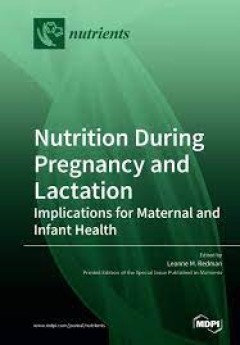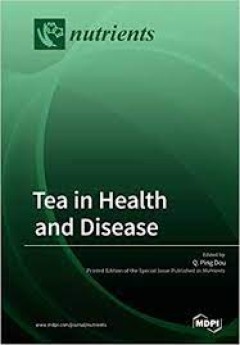Filter by

Boundary and Interior Layers, Computational and Asymptotic Methods - BAIL 2014
This volume offers contributions reflecting a selection of the lectures presented at the international conference BAIL 2014, which was held from 15th to 19th September 2014 at the Charles University in Prague, Czech Republic. These are devoted to the theoretical and/or numerical analysis of problems involving boundary and interior layers and methods for solving these problems numerically. The a…
- Edition
- -
- ISBN/ISSN
- 978-3-319-25727-3
- Collation
- -
- Series Title
- -
- Call Number
- 510

Nutrition During Pregnancy and Lactation : Implications for Maternal and Infa…
Pregnancy is a viewed as a window to future health. With the birth of the developmental origins of human adult disease hypothesis, research and clinical practice has turned its attention to the influence of maternal factors such as health and lifestyle surrounding pregnancy as a means to understand and prevent the inter-generational inheritance of chronic disease susceptibility. Outcomes during…
- Edition
- -
- ISBN/ISSN
- 978-3-03928-055-1
- Collation
- -
- Series Title
- -
- Call Number
- 572 NUT

Nutrition in Inflammatory Bowel Disease (IBD)
The purpose of this Special Issue “Nutrition in Inflammatory Bowel Disease (IBD)” is to increase knowledge regarding the role of dietary composition and effects in IBD, describing the prevalence of malnutrition in IBD and the effect on clinical outcomes, discussing methods of nutrition risk screening and assessment in IBD, and reviewing mechanisms through which diet and dietary components m…
- Edition
- -
- ISBN/ISSN
- 978-3-03921-440-2
- Collation
- -
- Series Title
- -
- Call Number
- 572 NUT

Transition to Higher Mathematics : Structure and Proof
This book is written for students who have taken calculus and want to learn what “real mathematics" is. We hope you will find the material engaging and interesting, and that you will be encouraged to learn more advanced mathematics. This is the second edition of our text. It is intended for students who have taken a calculus course, and are interested in learning what higher mathematics is al…
- Edition
- Second Edition
- ISBN/ISSN
- 9781941823033
- Collation
- -
- Series Title
- -
- Call Number
- 510 TRA

Tea in Health and Disease
Tea, made from the leaves of the Camellia senenisis plant, is the second most consumed beverage worldwide after water. Accumulating evidence from cellular, animal, epidemiological and clinical studies have linked tea consumption to various health benefits, such as chemoprevention of cancers, chronic inflammation, heart and liver diseases, diabetes, neurodegenerative diseases, etc. Although such…
- Edition
- -
- ISBN/ISSN
- 978-3-03897-987-6
- Collation
- -
- Series Title
- -
- Call Number
- 572 TEA

Difference Equations, Discrete Dynamical Systems and Applications ICDEA, Wuha…
These proceedings of the 20th International Conference on Difference Equations and Applications cover the areas of difference equations, discrete dynamical systems, fractal geometry, difference equations and biomedical models, and discrete models in the natural sciences, social sciences and engineering. The conference was held at the Wuhan Institute of Physics and Mathematics, Chinese Academy o…
- Edition
- -
- ISBN/ISSN
- 9783319247472
- Collation
- xvi, 195 pages
- Series Title
- -
- Call Number
- 515.625

Difference equations, discrete dynamical systems and applications : ICDEA, Ba…
These proceedings of the 18th International Conference on Difference Equations and Applications cover a number of different aspects of difference equations and discrete dynamical systems, as well as the interplay between difference equations and dynamical systems. The conference was organized by the Department of Mathematics at the Universitat Autònoma de Barcelona (UAB) under the auspices of…
- Edition
- -
- ISBN/ISSN
- 9783662529270
- Collation
- xii, 335 pages
- Series Title
- -
- Call Number
- 515.625

Biochemistry and Application in Medicine
Diabetes mellitus is a group of metabolic disorders leading to defects in insulin se- cretion and action of insulin or both. Diabetes is caused by a combination of hereditary and environmental factors. In the human body, blood glucose levels are controlled by a complex interaction of multiple chemicals and hormones, including insulin and glucagon. Insulin is a peptide hormone produced in …
- Edition
- -
- ISBN/ISSN
- -
- Collation
- -
- Series Title
- -
- Call Number
- 572 BIO

Polyhedral Structures, Symmetry, and Applications
Symmetry is an intriguing phenomenon manifesting itself in art, nature, and the mind. This Special Issue book features 19 articles about discrete geometric and combinatorial polyhedral structures, with symmetry as the unifying theme. These articles present an attractive mix of topics and have appeared in two related Special Issues of Symmetry, on "Polyhedra" in 2012/2013 and on "Polyhedral Stru…
- Edition
- -
- ISBN/ISSN
- 978-3-03842-688-2
- Collation
- -
- Series Title
- -
- Call Number
- 540 POL

Satellite Altimetry for Earth Sciences
Satellite altimetry is a radar technique for measuring the topography of the Earth’s surface. It was initially designed for measuring the ocean’s topography, with reference to an ellipsoid, and for the determination of the marine geoid. Satellite altimetry has provided extremely valuable information on ocean science (e.g., circulation surface geostrophic currents, eddy structures, wave heig…
- Edition
- -
- ISBN/ISSN
- 978-3-03897-681-3
- Collation
- -
- Series Title
- -
- Call Number
- 520 SAT
 Computer Science, Information & General Works
Computer Science, Information & General Works  Philosophy & Psychology
Philosophy & Psychology  Religion
Religion  Social Sciences
Social Sciences  Language
Language  Pure Science
Pure Science  Applied Sciences
Applied Sciences  Art & Recreation
Art & Recreation  Literature
Literature  History & Geography
History & Geography